
Ernest Gary Gygax was an American game designer and author best known for co-creating the pioneering tabletop role-playing game Dungeons & Dragons (D&D) with Dave Arneson.
Greyhawk, also known as the World of Greyhawk, is a fictional world designed as a campaign setting for the Dungeons & Dragons fantasy roleplaying game. Although not the first campaign world developed for Dungeons & Dragons—Dave Arneson's Blackmoor campaign predated it by about a year—the world of Greyhawk closely identified with early development of the game beginning in 1972, and after being published it remained associated with Dungeons & Dragons publications until 2008. The world itself started as a simple dungeon under a castle designed by Gary Gygax for the amusement of his children and friends, but it was rapidly expanded to include not only a complex multi-layered dungeon environment, but also the nearby city of Greyhawk, and eventually an entire world. In addition to the campaign world, which was published in several editions over twenty years, Greyhawk was also used as the setting for many adventures published in support of the game, as well as for RPGA's massively shared Living Greyhawk campaign from 2000 to 2008.
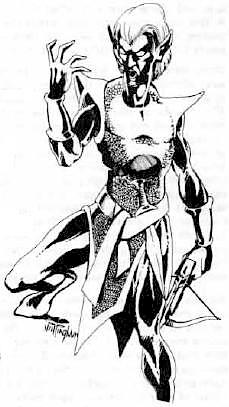
The drow or dark elves are a dark-skinned and white-haired subrace of elves connected to the subterranean Underdark in the Dungeons & Dragons fantasy roleplaying game. The drow have traditionally been portrayed as generally evil and connected to the evil spider goddess Lolth. However, later editions of Dungeons & Dragons have moved away from this portrayal and preassigned alignment. More recent publications have explored drow societies unconnected to Lolth.
A gelatinous cube is a fictional monster from the Dungeons & Dragons fantasy role-playing game. It is described as a ten-foot cube of transparent gelatinous ooze, which is able to absorb and digest organic matter.

Halflings are a fictional race found in some fantasy works. They tend to be depicted as physically similar to humans, except about half as tall and not as stocky as the similarly sized dwarves. Halflings are often depicted as having slightly pointed ears along with leathery-soled feet which are covered with curly hair. They tend to be portrayed as stealthy and lucky. The term is derived for the word used in Scotland, Northern Ireland, and Northern England for a child who is not yet fully grown. Halflings are found in many fantasy novels and games, including as an alternative term for hobbits in J. R. R. Tolkien's Middle-earth and as playable humanoid races in Dungeons & Dragons.
Gord the Rogue is the protagonist in a series of fantasy novels and short stories written by Gary Gygax. Gygax originally wrote the novels and short stories to promote his World of Greyhawk campaign setting for the Dungeons & Dragons role-playing game. After he left TSR, Gygax continued to write Gord the Rogue novels for several years. In all of these works, the plot revolves around the adventures of a young man named Gord who rises from humble origins in the slums of a large city on the planet Oerth to become a powerful force trying to stave off the takeover of Oerth by demons.
A displacer beast is a fictional evil feline creature created for the Dungeons & Dragons role-playing game in 1975; it has subsequently been included in every edition of the game to the present day.

Mordenkainen is a fictional wizard from the World of Greyhawk campaign setting for the Dungeons & Dragons roleplaying game. He was created by Gary Gygax as a player character, only months after the start of Gygax's Greyhawk campaign and is therefore one of the oldest characters continuously associated with Dungeons & Dragons.
In the Dungeons & Dragons fantasy roleplaying game, Tharizdun is the god of Eternal Darkness, Decay, Entropy, Malign Knowledge, Insanity, and Cold. He originated in the World of Greyhawk campaign setting but has since also appeared in other settings.
In the Dungeons & Dragons fantasy role-playing game, the undead are a broad classification of monsters that can be encountered by player characters. Undead creatures are most often once-living creatures, which have been animated by spiritual or supernatural forces. They range from mindless remnants of corpses such as skeletons and zombies to highly intelligent creatures like vampires and liches, but in whatever form they take they are typically malevolent and threatening. Like most Dungeons & Dragons monsters, the various kinds of undead creatures are "drawn from classical, medieval, and fictional sources", and have in turn influenced the use of these kinds of monsters in other games.
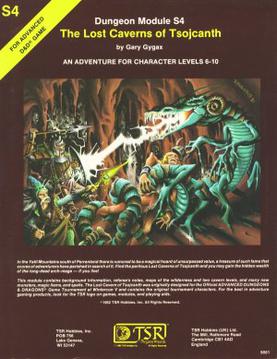
The Lost Caverns of Tsojcanth is an adventure module for the Dungeons & Dragons fantasy role-playing game. It was written by Gary Gygax and published by TSR in 1982 for the first edition Advanced Dungeons & Dragons (AD&D) rules. The 64-page adventure bears the code "S4" and is set in the Greyhawk campaign setting. It is divided into two parts, a 32-page adventure, and a 32-page booklet of monsters and magic items. The plot involves the player characters investigating rumors of lost treasure. After traversing a wilderness and two levels of dungeons, the players face Drelnza, the vampiric daughter of long-deceased archmage Iggwilv.

The lich is an undead creature found in the Dungeons & Dragons (D&D) fantasy role-playing game. Liches are spellcasters who seek to defy death by magical means.
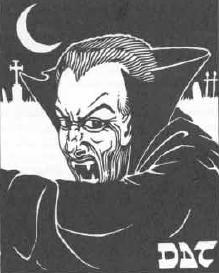
In the Dungeons & Dragons fantasy role-playing game, a vampire is an undead creature. A humanoid or monstrous humanoid creature can become a vampire, and looks as it did in life, with pale skin, haunting red eyes, and a feral cast to its features. A new vampire is created when another vampire drains the life out of a living creature. Its depiction is related to those in the 1930s and 1940s Hollywood Dracula and monster movies. In writing vampires into the game, as with other creatures arising in folklore, the authors had to consider what elements arising in more recent popular culture should be incorporated into their description and characteristics.
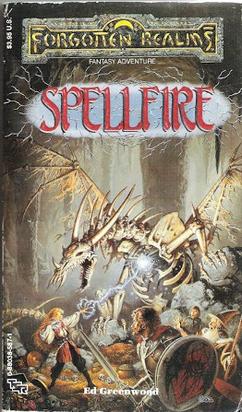
Spellfire is a fantasy novel written by Ed Greenwood and published in 1987. It is the first novel in Ed Greenwood's book series, Shandril's Saga, and takes place in the Forgotten Realms setting based on the Dungeons & Dragons fantasy role-playing game.

Pool of Radiance is a novel based on the Pool of Radiance computer role-playing game. It was written by James Ward and Jane Cooper Hong, and published by TSR in November 1989. The novel is set in the Forgotten Realms setting based on the Dungeons & Dragons fantasy role-playing game. This book was the first in a trilogy, followed by Pools of Darkness and Pool of Twilight.
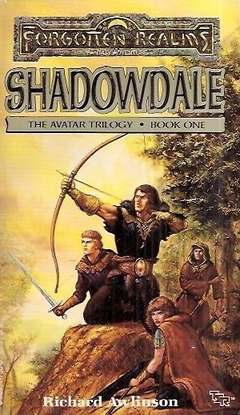
Shadowdale is the first book in The Avatar Series, written by Scott Ciencin—originally under the pen-name 'Richard Awlinson'.

Saga of Old City is a 1985 fantasy novel by Gary Gygax, set in the world of Greyhawk, which is based on the Dungeons & Dragons fantasy role-playing game.
This is a bibliography of American game designer and author Gary Gygax.








